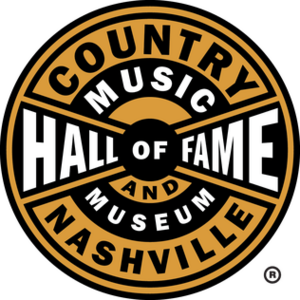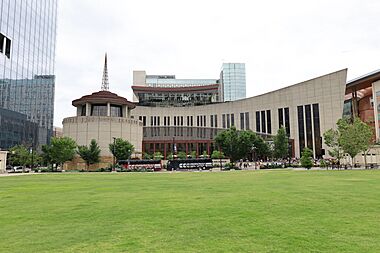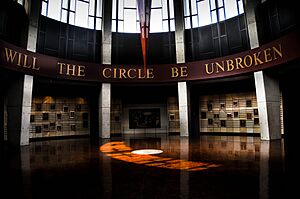Country Music Hall of Fame and Museum facts for kids
 |
|

The front of the building in 2022
|
|
| Established | 1967 |
|---|---|
| Location | 222 Rep. John Lewis Way S Nashville, Tennessee 37203 |
| Type | History museum |
| Visitors | ~ 1,600,000 (2023) |
The Country Music Hall of Fame and Museum is a famous museum in Nashville, Tennessee. It is one of the biggest museums in the world that is all about American country music. The museum was started in 1964. Its job is to protect and share the history of this music style. Over the years, it has gathered one of the largest music collections anywhere.
Contents
History of the Museum
The Country Music Hall of Fame and Museum holds the world's largest collection of country music items. In the 1960s, the Country Music Association (CMA) wanted more people to know about country music. They decided a special museum was needed.
A non-profit group called the Country Music Foundation (CMF) was created in 1964. The CMF raised money to build the museum, which opened on April 1, 1967. The first building looked like a barn and was located on a famous street called Music Row.
In the 1970s, the museum's library grew. It collected recordings, books, photos, and other important papers. By 1972, the museum had its own staff to run things. The building was made bigger in 1974, 1977, and 1984 to make room for its growing collection of costumes, historic cars, and musical instruments.
The Museum Today
To make it easier for people to visit, the museum moved to a new, larger building in downtown Nashville in May 2001. In 2014, the museum expanded again, doubling its size. It now has more space for galleries, classrooms, and stores.
The museum's main exhibit is called Sing Me Back Home: A Journey Through Country Music. It tells the story of country music using real items, photos, videos, and interactive screens. There are also special exhibits that change over time. One gallery, called American Currents: State of Music, shows what's new in country music.
Besides the galleries, the museum has a 776-seat theater and the Taylor Swift Education Center. It also owns other historic places. These include Hatch Show Print, an old printing shop, and the famous RCA Studio B. Many stars like Elvis Presley and Dolly Parton recorded songs at Studio B.
The museum offers many educational programs, like songwriting classes for schools. It also has its own record label, CMF Records, which has won Grammy Awards.
Inside the museum, there is a large painting called The Sources of Country Music. It was the last work of the artist Thomas Hart Benton.
What is the Country Music Hall of Fame?
For a country music professional, becoming a member of the Country Music Hall of Fame is the greatest honor they can receive. This honor is given to performers, songwriters, and other important people for their work in country music.
The Hall of Fame was created in 1961 by the Country Music Association (CMA). The first members were Hank Williams, Jimmie Rodgers, and Fred Rose. Roy Acuff was the first living artist to be added, in 1962. The most recent members are Tony Brown, June Carter Cash, and Kenny Chesney.
New members are chosen every year by a group of music industry experts. They are officially welcomed at a special Medallion Ceremony. The museum itself does not choose the members, but it displays special bronze plaques for each one.
The Museum's Amazing Collection
The museum's collection shows the history of country music from its beginnings to today. Items that are not on display are kept in a large, safe, climate-controlled storage area.
The collection includes:
- Over 250,000 sound recordings, including almost all country songs released before World War II.
- About 500,000 photos.
- More than 30,000 videos and films.
- Over 900 musical instruments. This includes Mother Maybelle Carter's guitar, Bob Wills's fiddle, and Bill Monroe's mandolin.
- Thousands of stage costumes, from sparkly suits to cowboy boots and hats.
- Handwritten song lyrics, letters, and fan club papers.
- Famous cars, like Elvis Presley's 1960 "Solid Gold" Cadillac and Webb Pierce's 1962 Pontiac Bonneville.
Cool Building Design
The museum's building in downtown Nashville has a very creative design.
- From the sky, the building is shaped like a giant bass clef.
- The front windows look like the keys of a piano.
- A tower on the roof is shaped like the famous radio tower for station WSM.
The round part of the building, called the Rotunda, is full of symbols.
- The four levels on its roof look like different types of records: a 78, a vinyl LP, a 45, and a CD.
- The stone bars on the outside wall represent the notes of the famous song "Will the Circle Be Unbroken".
- Inside, the bronze plaques honoring the Hall of Fame members are arranged to look like notes on a sheet of music.
The building was made with materials like wood, concrete, and stone. This is a reminder that country music has strong roots in the lives of working people.
See also
 In Spanish: Museo y Salón de la Fama del Country para niños
In Spanish: Museo y Salón de la Fama del Country para niños
- List of Country Music Hall of Fame inductees
- List of music museums




